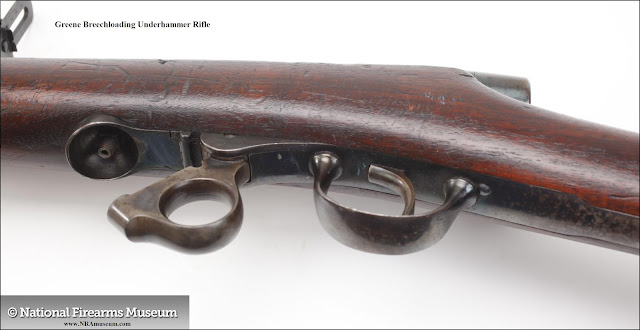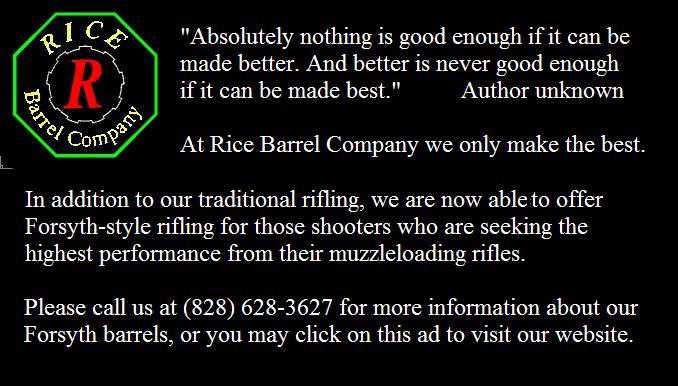Greene Breechloading Underhammer Rifle
.
 |
| Clicking on the photos will enlarge them for closer viewing. Clicking the White X in the upper right corner will return you to the text. |
When gun talk gets around to bolt-action rifles, the question might arise as to which one was the first U.S. military bolt action. Some might point to the Krag or perhaps the Winchester Hotchkiss or maybe the Remington Keene (don’t think those last two were ever really accepted by the Army). While all these designs were spawned in the late 1800s, there was one that preceded the earliest of them by at least a decade.
Those rifles mentioned were, of course, cartridge arms and this site is dedicated to muzzleloading arms and specifically those of underhammer design. So why in blazes are we talking about bolt action rifles!?
Well, prior to the War Between the States, there was an ingenious Army Colonel who apparently couldn’t sleep nights as he was obsessed with an idea for a new rifle for the Army. He must have reasoned that a rifle action based upon the bolt that held the outhouse door secure might work. His diligence brought us The First U.S. bolt action rifle – and it’s an underhammer at that! Yup, an underhammer bolt action.
Patented on November 17, 1857, Greene's Breechloading Rifle, with its underhammer design and unusual .53 caliber oval-shaped bore, was the brainchild of U.S. Army Lt. Col. J. Durrell Greene. Interestingly, Greene purchased the machinery for producing his oval-bored barrels from Charles Lancaster of London, England. Production of Greene's rifles began in 1859 and on through the early 1860s. Yes, that’s Civil War production.
 |
| Patented in 1857! |
Greene’s rifles were manufactured by A. H. Waters of Millbury, Massachusetts with approximately 1,500 Greene Rifles being produced for sale in the United States. An additional 3,000 were made for the Russian government. Although the Greene was the first U.S. military bolt-action rifle, only 900 were actually purchased by the U.S. Army. But purchased they were and having had actual use in the war that gives the Greene the distinction of being the very first U.S. military bolt action rifle, according to the NRA Firearms Museum, www.NRAmuseum.com.
As mentioned, the bore was .53 caliber with a barrel measuring 35" and an overall rifle length of 53.5". The design also included a bayonet and a buttstock compartment with trapped buttplate for holding cleaning accoutrements.
As mentioned, the bore was .53 caliber with a barrel measuring 35" and an overall rifle length of 53.5". The design also included a bayonet and a buttstock compartment with trapped buttplate for holding cleaning accoutrements.
Unlike other percussion arms, these rifles required the percussion cap to be placed on a coned nipple that was located under the barrel. However, when the hammer was cocked there was nothing to hold the cap in place. The result was that the cap could – and did - frequently fall off, often at rather inopportune moments.
(Of course, today we have solved that problem of the cap falling off the nipple in underhammer rifles with a very subtle redesign of the musket cap nipple - www.rjrenner.blogspot.com.)
Now here's where it gets really interesting. The Greene system required loading two bullets per shot. One of the bullets served as a projectile and one served as a gas seal. In the initial loading sequence, a bullet was inserted into the chamber, followed by a powder charge, then a second bullet was inserted behind the powder charge. No doubt the powder charge was contained in a combustible nitrated-paper cartridge. Don’t know that for certain, but just a logical guess. At least, that’s the way I would have done it.
The first bullet left the muzzle when the rifle was discharged, while the second remained in the breech to prevent propellant gasses from escaping past the bolt, thus sealing the chamber and breech. When the rifle was re-loaded, the former rear bullet was pushed forward into the bore, followed by another powder charge and a new "gas seal" bullet. The process would be continually repeated. Thus each bullet saw dual use - both as a breech gas seal, and as the projectile of the subsequent shot. |
| Clicking on this bottom view will allow you to see the striations on the nipple which helped secure the cap on the nipple. |
We can imagine that the rifle would have been fast to load and fire (except when that pesky cap falls off the nipple - now where did that little bugger go?). The oval bore provided sufficient accuracy and it shot very clean without conventional rifling lands to catch the powder residue. What little bore-cleaning that was needed was done in a snap! Aside from an occasionally dropped percussion cap, it seems that the rifle could sustain quite a formidable continuation of fire.
Quite ingenious really.
As to why the Greene didn't become famous for its role in the war as did all manner of other rifle designs, both good and bad, I can only surmise that it must have been politics - the bane of so many good ideas.
My thanks go to Ms. Caroline Simms at the NRA Firearms Museum for kindly arranging permission for us to share the photos of their prize with you readers. You can visit their site: www.NRAmuseum.com to see all the other amazing firearms in their fascinating collection.
BTW, if you come upon any other rare, weird, or otherwise interesting underhammers, please send me an e-mail with the link and we’ll see about sharing it with the readership.
As a little side note about underhammers, here’s a little quiz for you more scholarly types. Do any of you readers know what modern breechloading cartridge rifle is an underhammer action? If you think you know, click on the Comments link below and send your answer to me. I will post all the comments and see if anyone has figure it out. Who knows, perhaps you know of some which I hadn’t yet considered.
We'll see.
Cheers!
.








7 comments:
The Ruger #1 has an underhammer.
Well, folks, we have a winner! The Ruger No.1 (with which I have a love/hate relationship)is indeed an underhammer action.
Thanks for playing.
Cheers!
I thought the Ruger #1 has an internal hammer. How is this an underhammer?
Yes, the Ruger No. 1 does have an internal hammer. However, the hammer pivots on the same screw as the lever at the bottom of the action. So the hammer actually swings vertically upwards to make contact with the firing pin housed within the breechblock. Thus it is technically an underhammer action.
Pretty ingenious, actually. It's interesting to see how many firearms were inspired by the "not traditional" underhammer system.
Also interesting to note that many major arms designers had either an open or closet fascination with the underhammer system. Even the famous Jonathan Browning offered an underhammer as his first commercial firearm.
Cheers!
If you get this drop me a line, I've comments on "Correvon" pistol Tom
Hello Tom,
There is no means to contact you through the "Comment" feature of the this blog. So if you wish to make contact with me, please e-mail me at: underhammers@safe-mail.net.
Thanks for your input!
Cheers!
Roger
what metal was the bullet made from?
Post a Comment